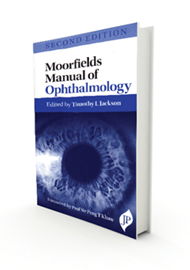The second edition of MMO edited by Timothy Jackson is a very handy practical resource for use in the eye casualty by doctors of all grades and nurse practitioners. It is a user-friendly, well presented manual, comprising 14 sections followed by appendices.
Each section deals with a specific subspecialty in ophthalmology and is written by world renowned experts in the field. The sections include chapters on relevant anatomy, history and examination, investigations, common clinical topics and finally optometry and general practice guidelines.
The chapters are concise, well-structured and have good quality colour photographs wherever required. This aids in recognition of conditions, especially by junior trainees, while the senior doctors would find it useful to jog their memory. The reader is guided through a brief introduction, relevant clinical history and examination, differential diagnosis, investigations and treatment algorithms. This layout is consistent in all chapters of the book. The structure helps with ease of understanding and gives the reader a clear sense of direction. While the chapters address a wide breadth of clinical topics, the reader would need to refer to a standard textbook to gain an in-depth insight. This is understandable as the book is designed to be a quick reference guide for use in a busy clinic.
A unique feature of the book is a step by step guide on procedures performed in an emergency or elective setting. The revised edition has updates on management addressing the demands of the ever changing face of ophthalmology. However, given the pace of change in certain subspecialties like medical retina, practice guidelines run the risk of becoming outdated very quickly. This could be dealt with by providing readers with access to an online electronic copy with relevant updates, as some publishers do. There are guidance notes for general practitioners and optometrists to aid in prioritising referrals. The appendix covers management of medical emergencies encountered in ophthalmology and other very clinically relevant data difficult to source.
This is a pocket size reference handbook that I have started to carry with me at all times. It is reasonably priced and provides good value for money. Being succinct and easy to read, I find it an invaluable resource. I would recommend this book for both beginners and established practitioners for use in everyday practice.




